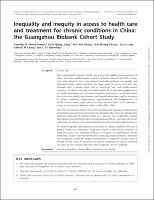| dc.description.abstract | Non-communicable diseases (NCDs) are a large and rapidly-growing problem in China and other middle-income countries. Clinical treatment of NCDs is long-term and expensive, so it may present particular problems for equality and horizontal equity (equal treatment for equal need) in access to health care, although little is known about this at present in low- and middle-income countries. To address this gap, and inform policy for a substantial proportion of the global population, we examined inequality and inequity in general health care utilization (doctor consultations and hospital admissions) and in treatment of chronic conditions (hypertension, hyperglycaemia and dyslipidaemia), in 30 499 Chinese adults aged ≥50 years from one of China's richest provinces, using the Guangzhou Biobank Cohort Study (2003-2008). We used concentration indices to test for inequality and inequity in utilization by household income per head. Inequality was decomposed to show the contributions of income, indicators of 'need for health care' (age, sex, self-rated health, coronary heart disease risk and chronic obstructive pulmonary disease) and non-need factors (education, occupation, out-of-pocket health care payments and health insurance). We found inequality and inequity in treatment of chronic conditions but not in general health care utilization. Using more objective and specific measures of 'need for health care' increased estimates of inequity for treatment of chronic conditions. Income and non-need factors (especially health insurance, education and occupation) made the largest contributions to inequality. Further work is needed on why access to treatment for chronic conditions in China is restricted for those on low incomes and how these inequities can be mitigated. | |

